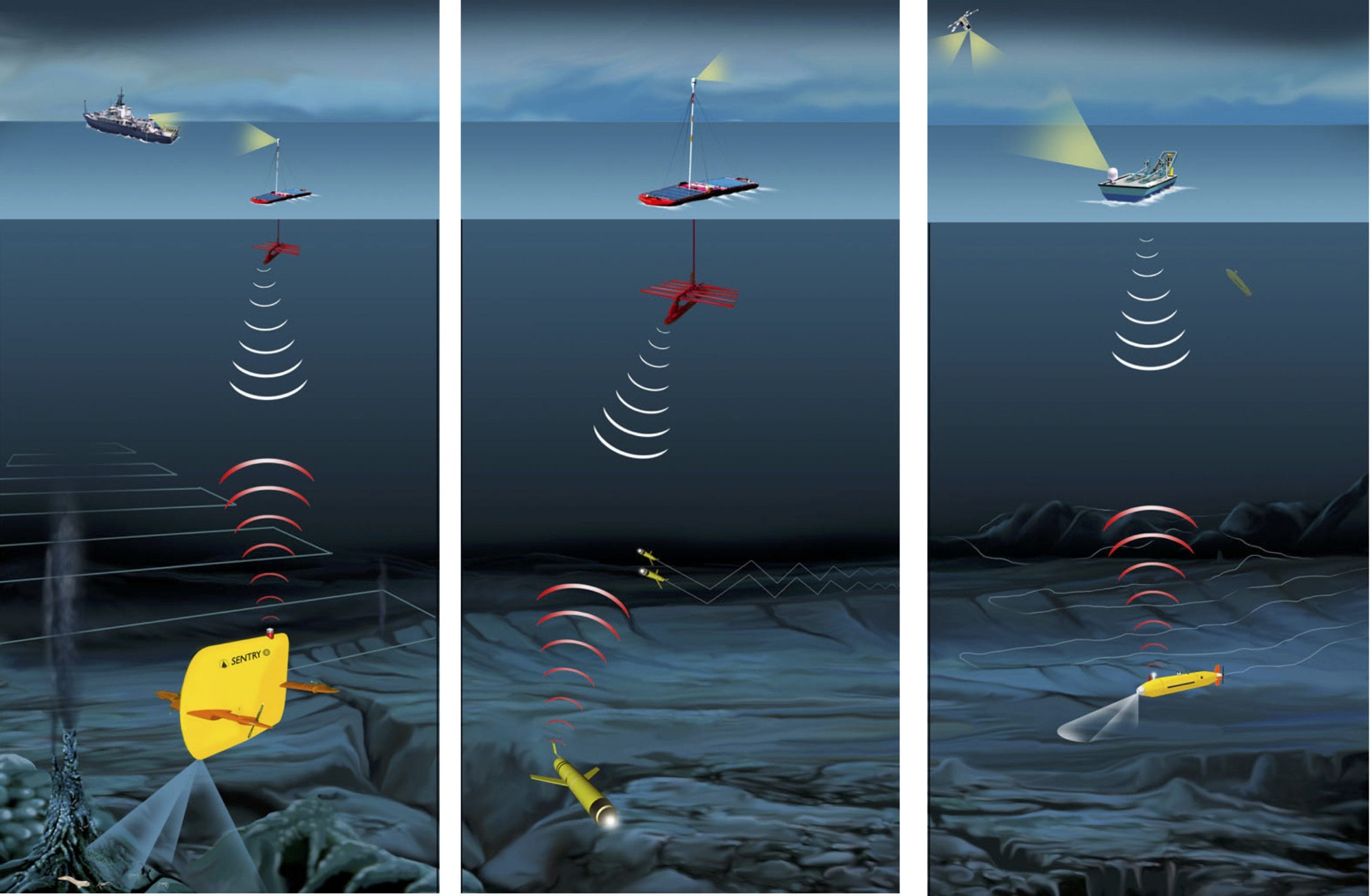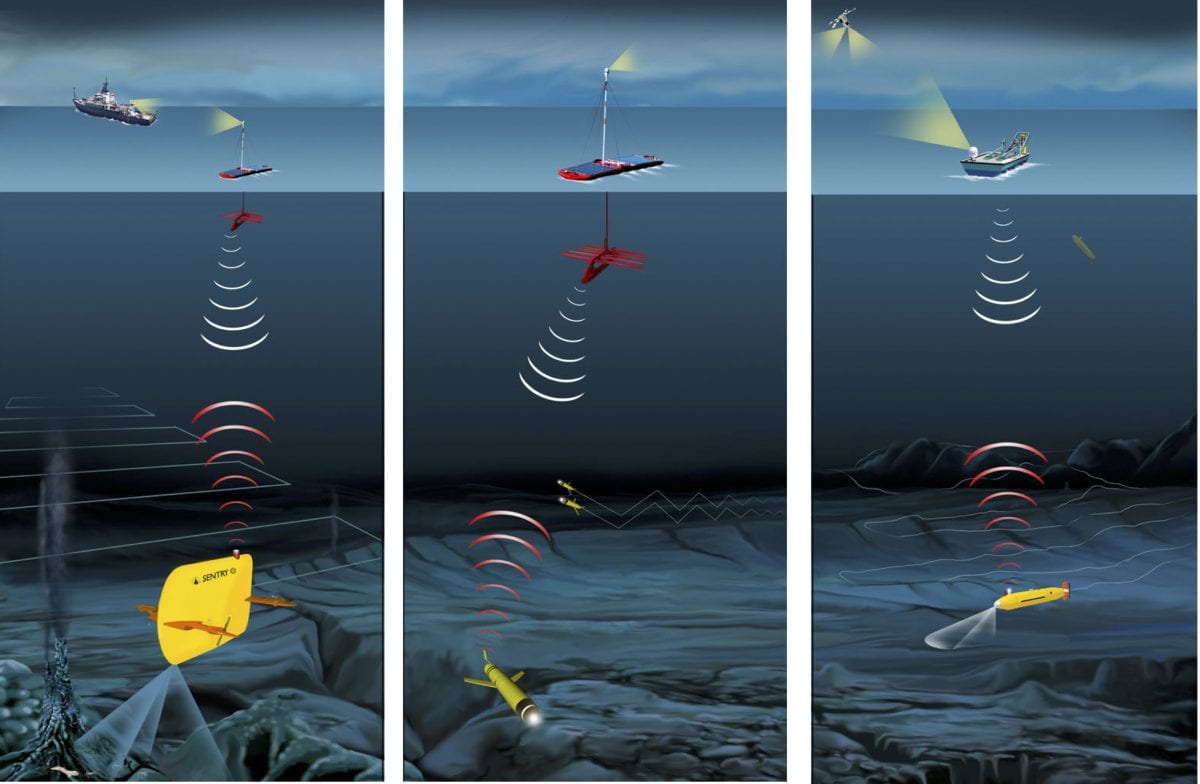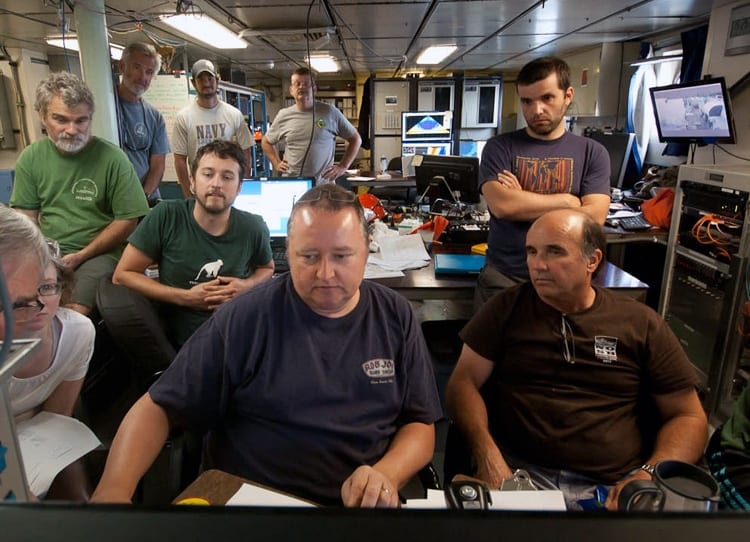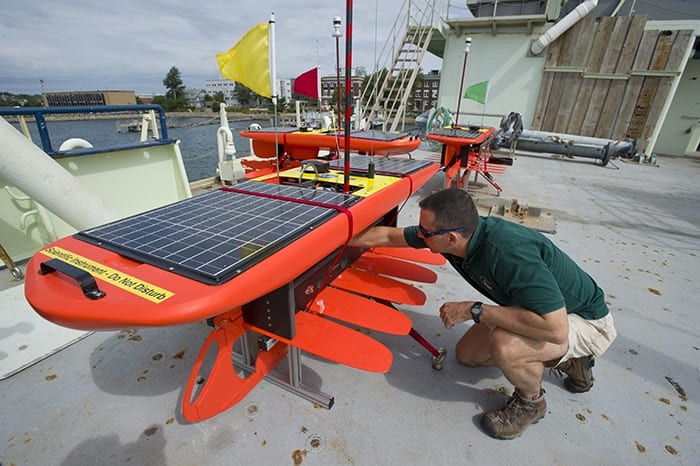Wave Glider provides gateway to remote exploration
Chris German's vision for robot-enabled exploration of Earth and other Ocean Worlds
By Elise Hugus | November 6, 2020

A phased approach: In tests planned for summer 2021, WHOI geochemist Chris German plans to use the Wave Glider and Sentry to explore the deep ocean (left panel). Next, he plans to use the Wave Glider with a fleet of autonomous underwater vehicles (middle panel). In the future, a self-sustaining Super Wave Glider could recharge deep-sea robots and sustain real-time communications to labs on shore (right panel).
In August 2021, WHOI geochemist Chris German will test an autonomous surface vehicle (ASV) called a Wave Glider while exploring the East Pacific Rise, a submarine volcanic chain in the southeastern Pacific Ocean. While WHOI’s more familiar autonomous underwater vehicle (AUV) Sentry is exploring the seafloor for hydrothermal vents at depth, it will relay data back acoustically via the Wave Glider. In this way, the Wave Glider acts as a “mid-ocean telephone operator” to researchers aboard the ship, allowing them to explore the seafloor miles ahead of the ship without Sentry ever having to come to the surface. Meanwhile, other researchers aboard the ship can sample previously discovered sites while the robots scout ahead to find new vent sites on the seafloor. Working together, the robots could more than double the science party's productivity.
German first demonstrated the Wave Glider's capabilities in a proof-of-concept test in Buzzards Bay, just offshore from WHOI, nearly a decade ago. Now poised to prove the approach in a deep-water setting, German anticipates the horizons for scientific exploration will open much wider, both here on Earth and on other Ocean Worlds.
Why does the Wave Glider interest you?
To understand our ocean fast enough to predict and manage the impacts of global change, we need to massively accelerate the pace at which we are exploring its vast unknowns. The Wave Glider is critical to that as a gateway. When used together with deep-diving robots, it can help reveal the hidden deep-ocean interior, beyond the reach of what satellites can see from space.
How does the Wave Glider work with existing underwater vehicles and what problems does it help solve?
Using the Wave Glider and an AUV like Sentry, together, will massively enhance the efficiency with which we can use large research ships to explore the ocean interior. Next summer, while the robots are deployed, my colleagues will simultaneously be using our ship to sample the water column. With the Wave Glider in the loop, I can take as much time as I need to explore for exciting new discoveries— without depriving my colleagues of valuable ship time. If Sentry finds anything interesting in its sensor data—if it “sniffs” a new vent—it will be able to alert me via the Wave Glider immediately. If I want to change its exploration strategy in response, say, to map the site or even take photographs, I will be able to relay those new instructions back to Sentry at the seafloor without interrupting what anyone else is doing. By the time my colleagues are ready to move on, I’ll already know the next “sweet spot” to bring the ship to. This is my vision for the future of marine robotics. Turning that vision into a reality could really help relieve the burden on access to our precious top-of-the-line research ships.
Chris German, center, directs hydrothermal sampling operations aboard ship based on real-time sensor data from a CTD-rosette. During the expedition, German's role was to identify the best place to collect the seawater samples that would then be sub-sampled by others for specialized geochemical measurements. (Brett Longworth, Woods Hole Oceanographic Institution)
What other extreme capabilities could the Wave Glider provide in the future?
Imagine a future in which a swarm of underwater robots are in communication with one Wave Glider “drone,” all working in tandem. The vehicles could be flying in formation to map large areas of seafloor, or investigating different depths across the ocean. Now step back and imagine multiple Wave Gliders patrolling the ocean surface— each with its own squadron of underwater vehicles— fanning out across the ocean, all coordinated from a single ship that transports them out to the study site and brings them home again.
Then, imagine if those Wave Gliders had enough endurance that the ship could leave them in place “treading water” for a year, or drive themselves out into the middle of the ocean without needing a ship to carry them there in the first place. Lastly, imagine what surface and deep ocean robots could do working in partnership. A larger version of today’s Wave Gliders could carry solar arrays large enough to recharge the rest of their underwater “squadron." When vehicles at depth run low on energy, they could drive up to the surface to recharge at these new “Super Wave Gliders,” using the navigation techniques we already have in place. Once their battery packs are recharged, each underwater craft could be directed back down to carry on working exactly where it left off. That may be a decade out, but it is coming.
What’s more, the same satellite communications we use to relay information via the Wave Glider to scientists on the ship could just as easily be used to relay information back to WHOI, day or night, via telepresence. Not only could scientists at WHOI be kept informed of what those robots were finding on the seafloor, but we could also keep all of those robots updated—and re-tasked as desired—on what they should do next. Lockdown during the COVID-19 pandemic has taught us that there’s no reason why we couldn’t get an alert in the middle of the night and reprogram robots on what to do next— without even leaving home!
Once we have proven the system with a single Wave Glider next summer, we expect NSF, the NOAA Ocean Exploration program, and others to take notice. And by the time we have worked out all the kinks, we’ll be ready to work with NASA to set the same strategies in motion to explore the recently discovered oceans on planets beyond Earth.
Former WHOI physical oceanographer Dave Fratantoni inspects a Wave Glider on the deck of R/V Knorr in 2012. The Wave Glider uses wave motion to propel itself through the ocean and solar-charged batteries to power its data collection sensors. (Tom Kleindinst, Woods Hole Oceanographic Institution)
How does robotic ocean exploration open up the inquiry into other Ocean Worlds?
Oceans are abundant throughout our solar system. The only conceivable way to explore these oceans is with advanced underwater robotics. That’s where WHOI comes in. Oceans might be a new domain for NASA, but we’ve been thinking about how to get to extreme places in Earth's ocean for decades.
Investing in these kinds of robotic advances should be a win-win for NASA and marine sciences alike. For NASA, everything we learn about our oceans can be applied to the exploration of oceans beyond Earth, including the fact that they may well have the capacity to host and sustain life. As one example, the Von Damm hydrothermal vent in the Caribbean is very similar in terms of temperature, mineral and chemical composition to what has been predicted on the seafloor of Saturn’s moon, Enceladus. It’s also the first site on Earth where WHOI scientists have demonstrated that a submarine vent can spontaneously generate key organic molecules critical to the origin of life. In terms of the benefits to ocean sciences, think of all the amazing engineering resources that NASA has access to. If we can partner with them to develop these robotic systems, our ability to explore Earth’s oceans will become so much greater.
Remember, one of humanity’s longest-asked questions is, “Are we alone in the Universe?" That question could be answered in our lifetime, using expertise that we have here at WHOI. We could go and look. We know how to do it, intellectually. It’s just a matter of making it happen.
The work described here was sponsored through the generosity of long-term friend and supporter of WHOI, Coleman (Coley) Burke. As this article was published, WHOI received the very sad news of Mr. Burke's passing.



